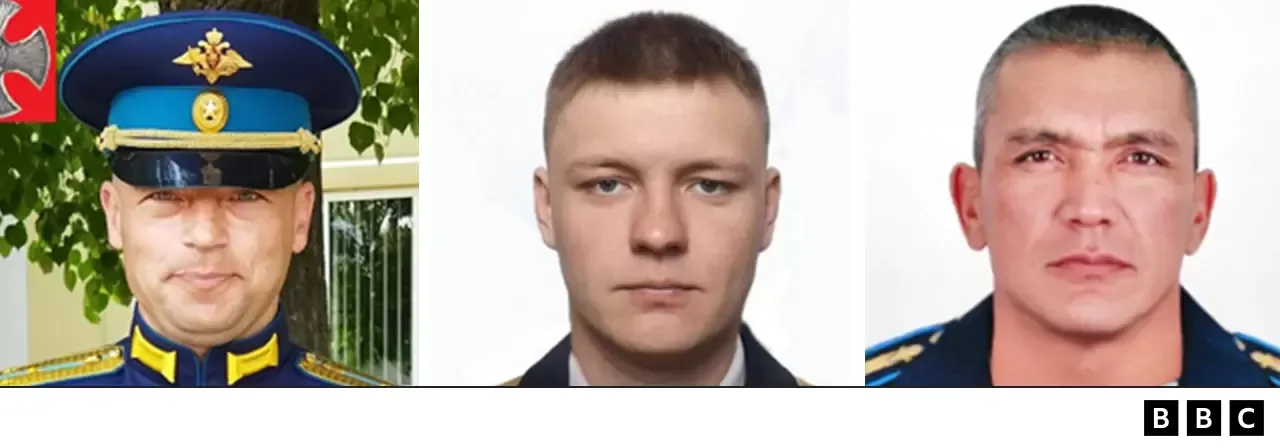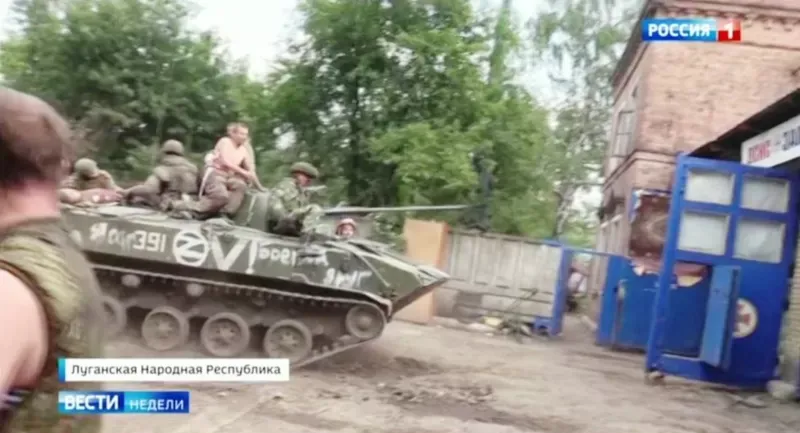One of the elite fighting forces of Russiathe 331st Guards Parachute Regiment, has returned to Ukraine after suffering heavy losses at the start of the war. While the state media talks about the heroism of the unit, in the city where the regiment is based, support for the fighters seems less clear.
___________________________
On the Donbas battlefield, an armored vehicle speeds toward a field hospital with several seriously wounded men. “The tank [ucraniano] he was shooting at us”, explains one of the Russian paratroopers, while his wounds are being treated”… “first close to us, then directly towards us”.
LOOK: What is Russia doing with Ukraine’s stolen grain?
Such glimpses into the bloody reality of this war are rare on the official Rossiya channel in early June. and the recognition of the price that the army is paying is increasingly scarce.
Something else about the images we saw caught our attention: that the soldiers were identified on Russian social media as belonging to the 331st Guards Parachute Regiment, a unit we learned about in early April.
In March the 331st Regiment, which until shortly before the invasion was based in Kostroma, 300 km northeast of Moscow, suffered heavy losses during the abortive advance on Kyiv*.
During the fighting from 11 to 14 March, they were repeatedly hit by Ukrainian artillery while trying to enter the city of Bucha, the scene of horrific crimes against the local civilian population. Among those killed in the fighting in mid-March was Colonel Sergei Sukharev, commander of the 331st regiment, several other officers and dozens of men.
Many of the soldiers were listed as “disappeared”, meaning that they died in circumstances such as the explosion of armored vehicles, in which it was impossible to recover their bodies. But the memorial walls of the Russian social network V’Kontakte, similar to Facebook, give a good idea of the confirmed fatalities and the anguished reaction of the population.
Heroes or victims?
Watching the local media in Kostroma after these initial losses, it appears that the Russian authorities became concerned about leaving the public in the dark about what was happening with the 331. In May, they sent a group of former officers to speak with the paratroopers, who returned to reassure the public on a local television channel.
“We wanted to check it out for ourselves,” Colonel Nikolai Mayorov, a retired regimental commander, told the interviewer. “We were convinced that his mood was good.”
And as if addressing citizens bewildered about the purpose of this war, Mayorov added: “They know what they do, they know why they do it.”
In official ceremonies you can see how a street is named after Colonel Sukharev,there is a school that commemorates Danil Turapov, a paratrooper killed in the same battle, or funds are raised to send comfort packages to soldiers. It is evident that the relatives of the soldiers feel a strong common bond, but this is not so among the community in general.
The video of a concert organized by the relatives of the members of the 331 regiment, on the occasion of the Victory Day celebrated annually in Russia on May 9, shows an exuberant performance of patriotic songs in a public park in Kostroma. But wide shots reveal that hardly anyone is looking.
Ambivalence or even hostility towards the war in Ukraine is also present.
A Kostroma resident, who had been canvassing reactions to the city’s loss of men in Ukraine, said: “I feel sorry for each one of these boys, but I do not consider them heroes, but victims.”
From Russian and other open information sources, it is possible to trace what happened to the paratroopers after their unfortunate attack on Kyiv. The 331st regiment, like thousands of other Russian troops in that part of northern Ukraine, was withdrawn to neighboring Belarus in late March.
In early April, their vehicles were filmed being loaded onto railway carriages in Baranovichi, Belarus, from where they were moved about 1,000 kilometers to Belgorod, a Russian city bordering eastern Ukraine. This was part of the displacement to Donbas, in eastern Ukraine.
After a period of rest, the 331 returned to action during the April fighting near Izyum in eastern Ukraine. After weeks without new casualties, we are starting to see new entries on the memorial walls on social media.
By the end of May, Russian attention had shifted some 100 km to the southeast, towards Popasna, where the invading forces began to advance against the Ukrainian defenders.
It is in the battles in that corner of Luhansk that have been fought over the last few weeks that the 331st has been involved once again and in which the remarkable images of its men were taken, shown by the state television channel Rossiya .

The airborne combat vehicle, or to use the Russian initials, BMD, featured in that recording has been daubed with so many symbols and letters that it has become something of a tableau for 331 and its grim collective experience.
The troops that participated in the main offensive towards Kyiv painted a white V on the sides of their vehicles, and the Kostroma regiment another paint stroke that looks as if an exclamation point has been placed on the inverted triangle, which is a standard marking. and a three-digit serial number. Loaded onto the flatcars upon their return to Belarus at the end of March, this is how the BMDs were marked.
But the soldiers kept adding paint, and perhaps their officers tolerated it because they thought it might keep morale up. One of the same combat vehicles we saw on a flatcar earlier in April in Belarus had this month in Luhansk added a painted “Z,” the Kremlin’s favorite symbol for war, the words “Kostroma” and “combatant friend.” on its sides. On top of the other symbols, the original green has almost disappeared.

As for the human cost of this long fight, our regimental verified kill count has gone from 39 in early April to 62 today. Taking into account the number of missing soldiers and some names that have not been published, the actual number of casualties is significantly higher and could be as high as 120.
If the wounded are added at a ratio of three to one, the total casualties are likely to be between 400 and 500. This is about half the number that the 331st regiment would have entered the Ukraine in February.
The impact on Kostroma is somewhat greater because the 1065th Airborne Artillery regiment, also from that city, has been fighting alongside the 331st in the Ukraine, and has also suffered casualties.
Local media have confirmed that more than 80 Kostroma soldiers have been killed in the months since the end of Februarywhich compares with the 56 who died during the Soviet Union’s nine-year war in Afghanistan.
*BBC Mundo has decided to adopt Kyiv when naming the capital of Ukraine to more accurately reflect its original spelling in Ukrainian.
Maria Jevstafjeva contributed information to this story.
The BBC has so far verified the deaths of 62 soldiers from the 331st Parachute Regiment.: Klim Abramov, First Lieutenant Rustem Akhmedyanov, Viktor Baranchikov, Oleg Bedoshvili, Captain Yurii Borisov, First Lieutenant Ilya Chernyshev, Corporal Yuri Degtaryov, Konstantin Dobrynin, Sasha Dolkin, Maksim Dubov, Sergeant Sergei Duganov, Sergeant Andrey Dunayev, Kiril Fedoseyev, Artur Imangulov , Lieutenant Yury Inkin, Maksim Ivanov, Lieutenant Nikolai Kirkin, Andrey Kovalevsky, Major Sergei Krylov, Utemes Kuanshpekov, Artem Kuprichenko, Stanislav Kutelev, Sergey Lebedev, Corporal Yanosh Leonov, Sergeant Alexander Limonov, Snr WO Sergei Lobachyo, Nikita Lomakin, Pavel Makarov, Artem Makhov, Corporal Ivan Mamzurin, Corporal Ilya Martynenko, Oleg Melnikov, Major Vadim Netuzhilov, Sergeant Aleksandr Nikitin, Alexey Ostanin, Lieutenant Lev Ovchinnikov, Maksim Ovchinnikov, Corporal Leonid Panteleyev, Major Oleg Patskalyev, Sergeant Stanislav Petrutik, Corporal Zakhar Polevschikov, Sergeant Roman Pomelov, Dmitry Prokopov, Snr WO Pavel Rudenko, Senior Lieutenant Alexander Shalygin, Aleksey Shevelev, Egor Shukhov Colonel Sergei Sukharev, Major Evgeny Sulokhin, Maxim Svetlenko, First Lieutenant Nikolai Symov, Daniil Titov, Maxim Trokai, Danil Turapov, Ivan Turyev, First Lieutenant Andrei Vashkov, Sergeant Maxim Vorotyntsev, Captain Alexei Vyshegorodtsev, Alexei Yelimov, Corporal Artem Yergin, Sergeant Ravshan Zhakbaev, Corporal Danila Zudkov.
Source: Elcomercio
I, Ronald Payne, am a journalist and author who dedicated his life to telling the stories that need to be said. I have over 7 years of experience as a reporter and editor, covering everything from politics to business to crime.

:quality(75)/cloudfront-us-east-1.images.arcpublishing.com/elcomercio/GMGD2OADDZEGZK4T5BZ5KBIJDE.webp)


:quality(75)/cloudfront-us-east-1.images.arcpublishing.com/elcomercio/BUNML4TQNVHSBOBMY5FC3QEM2M.jpg)

:quality(75)/cloudfront-us-east-1.images.arcpublishing.com/elcomercio/FGNDNEX4V5AKXF6INLTN4FLZUQ.jpg)
